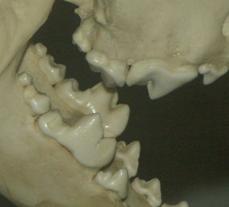Carnassials
Carnassials are large, sharp teeth found in many carnivorous mammals, designed for shearing flesh to facilitate the consumption of meat. Situated towards the back of the mouth, these teeth are pivotal in the predator's feeding mechanism, allowing for the efficient processing of prey. The carnassials are typically the last upper premolar and the first lower molar teeth, which work together like scissors to slice through meat.
Anatomy and Function[edit | edit source]
The primary function of the carnassials is to shear or slice flesh, enabling carnivores to bypass the need for chewing their food in the manner of herbivores. This adaptation is crucial for predators that need to consume large amounts of meat to meet their energy requirements. The unique alignment and shape of these teeth allow them to pass each other closely, cutting through muscle and sinew with minimal effort.
Evolution[edit | edit source]
The evolution of carnassials is a hallmark of the order Carnivora, which includes families such as cats, dogs, and mustelids. These teeth have evolved to optimize the consumption of meat, reflecting the dietary habits of these animals. The development of carnassials is one of the key adaptations that have enabled carnivores to occupy a wide range of ecological niches as effective predators.
Variation Among Species[edit | edit source]
While all carnassials share the common function of shearing flesh, there is considerable variation in their size, shape, and sharpness among different species of carnivores. For example, the carnassials of felids (cats) are highly specialized and sharp, reflecting their strict carnivorous diet. In contrast, the carnassials of canids (dogs) are less sharp, as many species in this family have more omnivorous diets.
Importance in Fossil Record[edit | edit source]
Carnassials are of significant interest to paleontologists because they provide valuable insights into the dietary habits of extinct carnivores. The size and shape of carnassials can help scientists reconstruct the feeding behavior of ancient predators, offering clues about their ecology and interactions with prey species.
Conservation and Health[edit | edit source]
In living carnivores, the health of the carnassials is vital for their survival. Dental problems involving these teeth can severely impact an animal's ability to feed, leading to malnutrition or starvation. Conservation efforts sometimes include health monitoring and dental care in captive or endangered predator populations to ensure their well-being and survival.
Search WikiMD
Ad.Tired of being Overweight? Try W8MD's physician weight loss program.
Semaglutide (Ozempic / Wegovy and Tirzepatide (Mounjaro / Zepbound) available.
Advertise on WikiMD
|
WikiMD's Wellness Encyclopedia |
| Let Food Be Thy Medicine Medicine Thy Food - Hippocrates |
Translate this page: - East Asian
中文,
日本,
한국어,
South Asian
हिन्दी,
தமிழ்,
తెలుగు,
Urdu,
ಕನ್ನಡ,
Southeast Asian
Indonesian,
Vietnamese,
Thai,
မြန်မာဘာသာ,
বাংলা
European
español,
Deutsch,
français,
Greek,
português do Brasil,
polski,
română,
русский,
Nederlands,
norsk,
svenska,
suomi,
Italian
Middle Eastern & African
عربى,
Turkish,
Persian,
Hebrew,
Afrikaans,
isiZulu,
Kiswahili,
Other
Bulgarian,
Hungarian,
Czech,
Swedish,
മലയാളം,
मराठी,
ਪੰਜਾਬੀ,
ગુજરાતી,
Portuguese,
Ukrainian
Medical Disclaimer: WikiMD is not a substitute for professional medical advice. The information on WikiMD is provided as an information resource only, may be incorrect, outdated or misleading, and is not to be used or relied on for any diagnostic or treatment purposes. Please consult your health care provider before making any healthcare decisions or for guidance about a specific medical condition. WikiMD expressly disclaims responsibility, and shall have no liability, for any damages, loss, injury, or liability whatsoever suffered as a result of your reliance on the information contained in this site. By visiting this site you agree to the foregoing terms and conditions, which may from time to time be changed or supplemented by WikiMD. If you do not agree to the foregoing terms and conditions, you should not enter or use this site. See full disclaimer.
Credits:Most images are courtesy of Wikimedia commons, and templates Wikipedia, licensed under CC BY SA or similar.
Contributors: Prab R. Tumpati, MD

